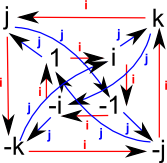On the previous pages we saw how to combine two or more groups into a bigger group, here we look at the reverse process, that is, breaking a group down into two or more simpler groups.
Lets assume that we have a group G and we have a subgroup of G which we call N. We want to find the other subgroup G/N. For G/N to be a group then N must be a normal subgroup.
Test that N is a normal subgroup
To test that N is a normal subgroup then:
x N x-1 must be a member of N for every x in G
Calculation of G/N
we calculate the set:
aN | a![]() G
G
This will be the group G/N under the operation
(a N) (b N) = a b N
Example 1 - divide C by Z2
G = Complex numbers = C
N = Z2
Test for Normal Subgroup
| x | x N x-1 |
|---|---|
| 1 | 1 {1,-1} 1 = {1,-1} |
| -1 | -1 {1,-1} -1 = {1,-1} |
| i | i {1,-1} -i = {1,-1} |
| -i | -i {1,-1} i = {1,-1} |
So x N x-1 is a member of N for every x which means that G/N will be a group and we can go on to calculate it.
Calculation of G/N
Elements of G/N are a•N:
1•{1,-1} = {1,-1}
-1•{1,-1} = {-1,1}
i•{1,-1} = {i,-i}
-i•{1,-1} = {-i,i}
so the elements are:
{1,-1} and {i,-i}
Example 2 divide H by C
G is the group of quaternions H:
Cayley Table |
Cayley Graph |
|||||||||||||||||||||||||
|
 |
Note: in this example I have not shown the negative elements so where i is shown we also have -i and so on for the other elements.
We want to divide it by C to get H/C
Test for Normal Subgroup
| x | x K x-1 |
|---|---|
| 1 | 1 {1,i} 1 = {1,i} |
| i | i {1,i} -i = {-1,-i} |
| j | j {1,i} -j = {-1,-i} |
| k | k {1,i} -k = {-1,-i} |
So x K x-1 is a member of K for every x which means that G/K will be a group and we can go on to calculate it.
Calculation of G/N
Elements of G/N are a•N:
1•{1,i} = {1,i}
i•{1,i} = {-1,i}
j•{1,i} = {j,-k}
k•{1,i} = {k,-j}
So the elements are:
{±1,±i} and {±j,±k}
which gives the multipication table:
| a*b | {±1,±i} | {±j,±k} |
| {±1,±i} | {±1,±i} | {±j,±k} |
| {±j,±k} | {±j,±k} | {±1,±i} |